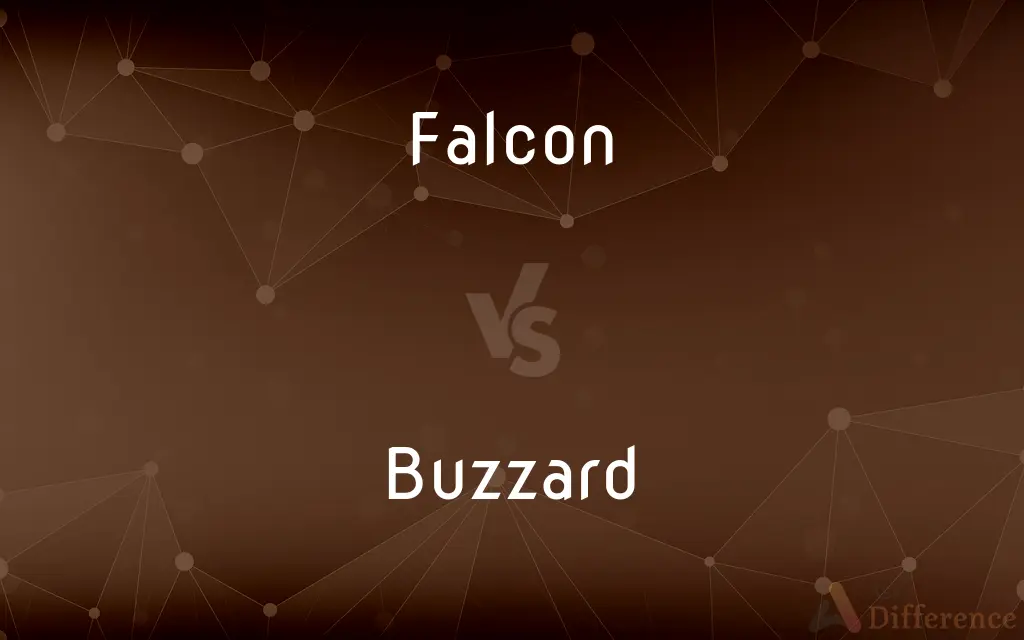Falcon vs. Buzzard — What's the Difference?
By Urooj Arif & Maham Liaqat — Updated on March 27, 2024
Falcon is known for its incredible speed and hunting prowess, while buzzards are larger, with broader wings and rely on soaring to locate prey.

Difference Between Falcon and Buzzard
Table of Contents
ADVERTISEMENT
Key Differences
Falcon, characterized by its remarkable speed, excels in hunting mid-flight, diving at high velocities to catch prey. Buzzards, on the other hand, have broader wings and tails, enabling them to soar and glide while scanning the ground for food.
While falcons possess sharp, pointed wings that allow for rapid flying and sudden changes in direction, buzzards feature more rounded wings, designed for endurance and stability in the air. This distinction highlights the falcon's specialization in agility and the buzzard's adaptation to a soaring lifestyle.
In terms of diet, falcons typically hunt smaller birds or mammals, utilizing their speed and agility. Buzzards, however, are more versatile, feeding on a wide range of prey, from small mammals to carrion, showcasing their adaptability.
Falconry, a sport that involves hunting with trained birds of prey, traditionally favors falcons for their speed and trainability. Buzzards, while capable of being trained, are less commonly used due to their more sedentary hunting techniques.
The nesting habits of these birds also differ significantly. Falcons prefer to nest on high cliffs or tall structures, using their elevated position to spot and dive at prey. Buzzards, conversely, often build their nests in trees or on cliffs, relying less on elevation for hunting.
ADVERTISEMENT
Comparison Chart
Wing Shape
Sharp, pointed
Broad, rounded
Hunting Method
Dives at high speed
Soars and glides
Prey
Smaller birds, mammals
Small mammals, carrion
Falconry Use
Highly favored
Less commonly used
Nesting
High cliffs, tall structures
Trees, cliffs
Compare with Definitions
Falcon
Falcons use their speed and sharp talons to catch prey in mid-air.
A falcon was observed diving at breakneck speed to snatch a pigeon out of the air.
Buzzard
Builds nests in trees or on cliffs, less dependent on height for hunting.
The buzzard's nest, hidden in the fork of a large oak, contained three speckled eggs.
Falcon
Falcons are highly valued in falconry due to their trainability and hunting prowess.
The falconer released his trained falcon, which swiftly returned with a rabbit.
Buzzard
Exhibits a wide diet range and adaptability to different environments.
The buzzard has adapted well to various habitats, from woodlands to open fields, feasting on whatever prey is available.
Falcon
Known for their incredible flight speed, especially when diving for prey.
The speed of the falcon as it dived towards its prey was a breathtaking sight.
Buzzard
Buzzards rely on soaring and gliding to locate prey before swooping down.
A buzzard hovered in the air for minutes before suddenly dropping down to snatch a small rodent.
Falcon
Prefers to nest on high cliffs or tall man-made structures.
The falcon made its nest atop the cathedral's spire, using the height to survey the surrounding area for prey.
Buzzard
Less commonly used in falconry due to their less aggressive nature and hunting style.
Although not the first choice for many falconers, the buzzard demonstrates remarkable patience and skill in hunting.
Falcon
A bird of prey known for its incredible speed and agility in the air, belonging to the genus Falco.
The peregrine falcon is renowned for being the fastest bird, reaching speeds over 200 mph during its hunting stoop.
Buzzard
A broad-winged bird of prey, often seen soaring in the sky, belonging to the Buteo genus.
The buzzard circled overhead, its broad wings catching the thermals as it searched for food.
Falcon
A bird of prey with long pointed wings and a notched beak, typically catching prey by diving on it from above.
Buzzard
Buzzard is the common name of several species of bird.
Falcon
Any of various birds of prey of the family Falconidae and especially of the genus Falco, having a short, curved beak and long, pointed, powerful wings adapted for swift flight.
Buzzard
Any of various North American vultures, such as the turkey vulture.
Falcon
Any of several birds of these or related species, such as hawks, trained to hunt small game.
Buzzard
Chiefly British A hawk of the genus Buteo, having broad wings and a broad tail.
Falcon
A female bird of this type used in falconry.
Buzzard
An avaricious or otherwise unpleasant person.
Falcon
A small cannon in use from the 15th to the 17th century.
Buzzard
Any of several Old World birds of prey of the genus Buteo with broad wings and a broad tail.
Falcon
Any bird of the genus Falco, all of which are birds of prey.
Buzzard
(North America) Any scavenging bird, such as the American black vulture (Coragyps atratus) or the turkey vulture (Cathartes aura).
Falcon
(falconry) A female such bird, a male being a tiercel.
Buzzard
In North America, a curmudgeonly or cantankerous man; an old person; a mean, greedy person.
Falcon
(historical) A light cannon used from the 15th to the 17th century; a falconet.
Buzzard
(archaic) A blockhead; a dunce.
Falcon
To hunt with a falcon or falcons.
Buzzard
(golf) double bogey
Falcon
One of a family (Falconidæ) of raptorial birds, characterized by a short, hooked beak, strong claws, and powerful flight.
In the language of falconry, the female peregrine (Falco peregrinus) is exclusively called the falcon.
Buzzard
A bird of prey of the Hawk family, belonging to the genus Buteo and related genera.
Falcon
An ancient form of cannon.
Buzzard
In the United States, a term used for the turkey vulture (Cathartes aura), and sometimes indiscriminately to any vulture.
Falcon
Diurnal birds of prey having long pointed powerful wings adapted for swift flight
Buzzard
A blockhead; a dunce.
It is common, to a proverb, to call one who can not be taught, or who continues obstinately ignorant, a buzzard.
Falcon
Hunt with falcons;
The Arabs like to falcon in the desert
Buzzard
Senseless; stupid.
Buzzard
Common in South America and Central America and southern United States
Buzzard
The common European short-winged hawk
Common Curiosities
What do falcons typically eat?
Falcons mainly hunt smaller birds and mammals, using their incredible speed.
How do falcons catch their prey?
Falcons dive at high speeds to catch prey mid-flight.
Can buzzards be used in falconry?
While buzzards can be trained for falconry, they are less commonly used than falcons.
Are buzzards bigger than falcons?
Generally, buzzards are larger and have broader wings compared to falcons.
What distinguishes a falcon from a buzzard?
Falcons have sharp, pointed wings and are known for their speed, while buzzards have broader wings and rely on soaring.
Can buzzards eat carrion?
Yes, buzzards have a varied diet that can include carrion.
How do buzzards use thermals?
Buzzards utilize thermals to soar and glide, conserving energy while searching for prey.
What is the fastest bird in the world?
The peregrine falcon is the fastest bird, especially during its hunting dive.
What makes buzzards less favored in falconry?
Their less aggressive nature and more sedentary hunting style make buzzards less favored.
Do falcons build nests?
Falcons usually nest on high cliffs or tall structures, rather than building traditional nests.
How are falcons trained for hunting?
Falcons are trained through a process of conditioning and bonding with the falconer, learning to hunt on command.
Do falcons have any natural predators?
Falcons, being top predators, have few natural enemies, though eggs and young can be at risk from other birds or animals.
What type of habitats do buzzards prefer?
Buzzards are adaptable and can thrive in a variety of habitats, including woodlands and open fields.
What adaptations do falcons have for hunting?
Falcons possess sharp talons, keen eyesight, and incredible speed, making them effective hunters.
What are the nesting habits of buzzards?
Buzzards typically build their nests in trees or on cliffs, using branches and twigs.
Share Your Discovery

Previous Comparison
Brief vs. Succinct
Next Comparison
Elementary vs. PrimaryAuthor Spotlight
Written by
Urooj ArifUrooj is a skilled content writer at Ask Difference, known for her exceptional ability to simplify complex topics into engaging and informative content. With a passion for research and a flair for clear, concise writing, she consistently delivers articles that resonate with our diverse audience.
Co-written by
Maham Liaqat













































